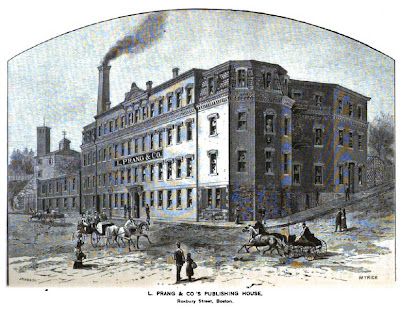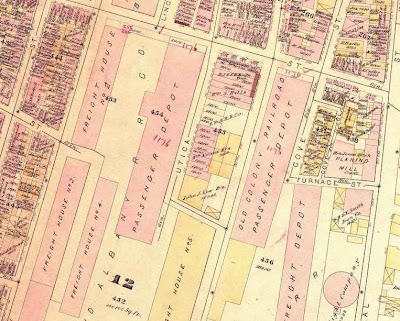 Louis Prang & Co. printing, Roxbury street. The building is still there.
Louis Prang & Co. printing, Roxbury street. The building is still there. Louis Prang Printing Company, Roxbury street (1884). Building marked with red star. The Prang house is shown at the back of the property, on Centre street.
Louis Prang Printing Company, Roxbury street (1884). Building marked with red star. The Prang house is shown at the back of the property, on Centre street.This entry strays from Boston Proper to Roxbury Crossing to remember Louis Prang, printer, and father of the American Christmas card. And unlike the subject of many entries, this original building still stands. Born in 1824, Louis Prang was a German immigrant who came to Boston in 1850. After failed attempts to enter into business, Prang found work as a wood engraver.
Prang began his career in lithography printing in 1856, and in 1860 bought out his partner and formed L. Prang and Co. A trip to Europe during the 1860s allowed Prang to learn the chromolithography process, which would revolutionize the printmaking and advertising fields with it's bright colors. The company produced both copies of popular paintings and album cards, meant to be collected. In 1873, the company entered the British Christmas card market, and the next year introduced the product to the United States (see below).
 L. Prang Christmas Card.
L. Prang Christmas Card. L. Prang chromolithograph print.
L. Prang chromolithograph print.The Prang company brought art to the middle class home at a reasonable price, bright colors (and many of them) to advertisements, and the tradition of exchanging Christmas cards (and all the other holiday cards to follow) to the American public. Louis Prang himself also supported the training of art teachers in the United States. His business just off Roxbury Crossing was a national leader, and he lived right behind it on Centre street, as was common of businessmen/entrepreneurs of the time.
The company merged with another in 1897 and moved to Springfield, Massachusetts. Louis Prang died twelve years later.



















